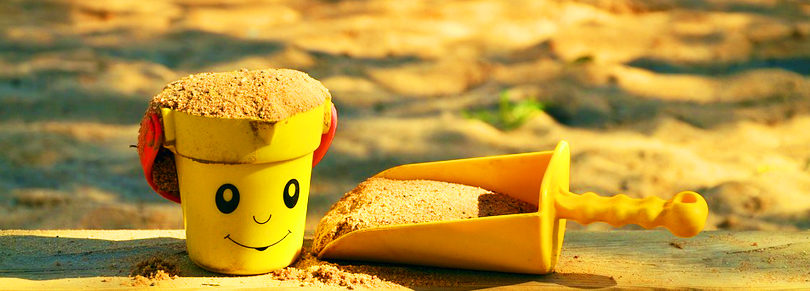I look forward to my weekly visits to the playgroup I am associated with. As soon as I enter the premises, time seems to slow down. I have a ritual of sitting down on the steps facing the sandpit; it is the real center of the school. As the children trickle in, they play around there till their entire class arrives.
This is the most essential ritual in the day where important information is shared, there are respectful silences, warm reunions, crucial discoveries, adult and child alike are engaged in the important business of wonder and curiosity. The adults are available and ensure they connect with each child before they enter class. This is important before they embark on the plans for the day. From these steps, I saw Amal. I noticed that his teacher was aware that he had arrived. She sat down near the sand pit.
Another child came, arranged few pebbles on the parapet. The teacher did not reach out for Amal like she had for the others. He stood there looking at the pebbles. He did not make eye contact. The teacher was humming a tune. Slowly he put his bag down, sat next to her, picked up the pebbles, rolled them in his hands, sitting very close to her as she continued singing. She put her hand on his. He let it stay there.
When the song was over, he picked his bag, put it where it was meant to be. He continued holding onto the pebbles, while the teacher helped him out of his shoes. They noticed a puddle and dipped their fingers into it, felt the water, he was squealing in delight. By this time the children had moved into class. It was only the two of them outside. She did not rush him.
She knew that this time together was important for the two of them, for him to trust and comply with her as the day progressed.
Connecting with your child is a process
Amal has difficulties in communication. He does not have the language and is unable to express his emotions in ways we would expect. Bonding with him meant that you needed to understand his ways of connecting. It had been a journey for his parents. In therapy, we traced back to his parents’ childhood, reconnecting with who they are as people and then moved on to how they see themselves as Amal’s parents.
The next step was analyzing Amal ’s Childhood , comprehending his ways of relating and their responses to him. Assimilating the spectrum of his diagnosis with his personality, temperament , his age and stage of development. Within this terrain, the challenges gradually seemed less overwhelming and the Amalness of Amal was more visible. With this lens, they introduced their child to his teacher.
This connect, was not only crucial for his compliance and learning, for him to develop relationships, it was essential for his parents and other significant adults to feel part of his growing up.
Acknowledging realities
Studies have shown that children with disabilities may display atypical patterns of attachment. Caring for a child with difficulties can get exhausting with the practicalities of care taking precedence. Along with that, the child’s inability to respond to their parents’ interaction often makes it stressful for the parents to connect. This in turn, may come in the way of the parent child attachment process. This may not be true for all children with special needs.
Slow down…
Remember, this person is your child, the disability being one aspect. The special needs have the capacity to take over your relationship with each other.
It becomes impertinent to create space, prioritise spending time together with age and capacity, and appropriate little rituals that help you connect with each other.
Find time for fun, for things you both enjoy doing with each other. Let them join into the chores you do, not for fine motor skills but for the conversation, the time together, the moments you co-create. Imagine for a moment, that his teacher had not taken that pause, Amal would have slipped in invisible, had a day full or protests, returned home to similar battles…with everyone in the equation feeling exhausted and frustrated. Handling him would then be a list of chores, rather than journeying his childhood.
Moments matter…
At the end of each school day, Amal’s teacher lingers on with Amal’s mother sharing the discoveries of the day. Amal cannot share them, nor does he add any verbal elements to them. But he does sit quietly on his mothers lap while she hears and engages with her through his eyes as she absorbs the story with him. This connect between the child and his parents is like a domino effect between the child and his teacher, between his teacher and his parents where for all those moments of sharing, they are talking about the child.
About the things he enjoys, what fascinates him, what he is wary of or what he avoids. In this, his landscape is that of him as a child, his challenges are an element of it, not the end all. These moments are enriching and fulfilling not only for Amal but for his mother as well.
Catch your breath
Bonding with your child is a process. Nurture your relationship consciously. Work with professionals to understand the diagnosis –the whys and whats of delays, behaviors and difficulties. Strive towards finding your rhythm together. Reach out to your systems of support; a world around you that can take over some responsibilities, share them, support with the bringing up of your child. And when you feel life is taking over, sit down on the step, acknowledge your feelings as they are real. Do something that helps you feel better.
Look around at those who are connecting with your child intuitively. Pause, catch your breath, reconnect with yourself. Antoine de Saint-Exupéry’s, the Little Prince, has a line summarising what our everyday realities have us forget “And now here is my secret, a very simple secret: It is only with the heart that one can see rightly; what is essential is invisible to the eye.”






Leave a Comment